Malfunction By definition, malfunction simply means failure to function properly. Misfire The hammer drops on a loaded gun but the cartridge never fires. Even though a misfire is a type of malfunction, "misfire" and "malfunction" are not interchangeable. Misfire simply means that the gun didn't fire. example of a misfire Hangfire The hammer drops, there is a perceptible delay, then the cartridge fires. The term does not mean the same thing as "misfire" even though the two have similarities. example of a hangfire Squib, Squib Load When the cartridge fires but doesn't have enough force to expel the bullet completely out of the barrel so the bullet becomes stuck inside the barrel. This is usually happens when the cartridge has no powder charge, a low powder charge, the powder charge has become contaminated and doesn't ignite, or when the primer doesn't ignite the power for some other reason. The shooter should notice when the cartridge does fire that the recoil felt weak and sounded more like a "pop" than a boom. Do not under any circumstance fire another round behind it. While a good quality gun may not be damaged, it's likely it will and a cheap low quality gun almost certainly will, and the shooter will probably be injured. There is a similar malfunction that can happen to cause a bullet to be stuck in the barrel called firing out of battery. If the cartridge fires when the slide isn't all the way forward (in battery) most of the gas is released through the ejection port rather than down the barrel. In this case the report of the explosion will sound louder than normal. Again in either case, an out of battery firing or a squib, do not fire another cartridge behind it as a bullet is probably stuck in the barrel. Notice that these can happen with any type of firearm, semi-auto pistols, revolvers, rifles, shotguns. examples of squib loads example of a catastrophic malfunction when firing after a squib load Jam The gun has jammed up somehow and won't operate properly. The term does mean the same thing as "misfire." According to some definitions, a jam is a malfunction that requires tools to fix. Double Feed When a cartridge has tried to feed into the chamber of a semi-automatic before the cartridge or empty case currently in the chamber has ejected. The term does not mean the same thing as "misfire."
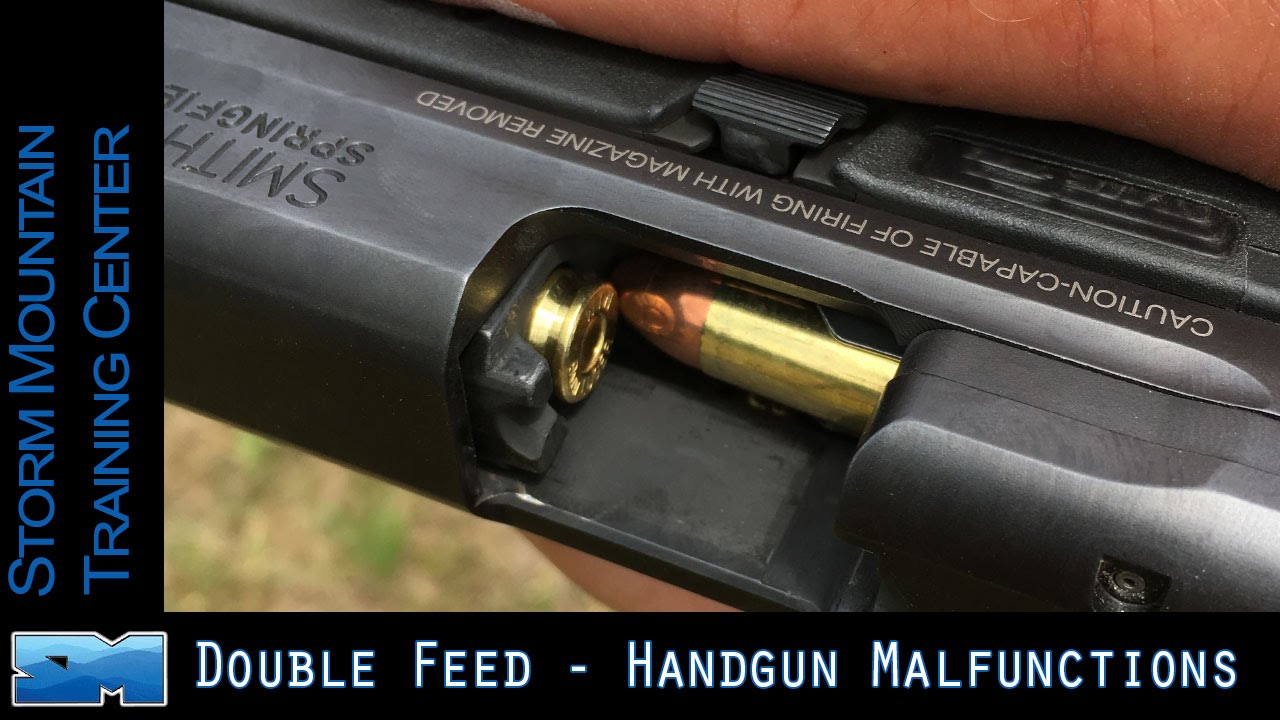
Bullet The actual projectile; the piece of lead or other material that leaves the barrel of the gun and travels to the target. The bullet is one of the components of a cartridge.

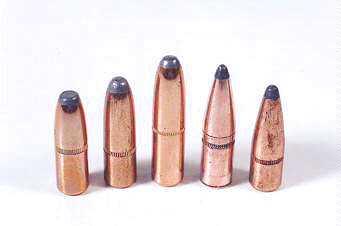 Cartridge
The entire assembled component containing the case, primer, powder charge, and bullet.
Also called a round or round of ammo. The term is not interchangeable with "bullet."
Even though it has become commonplace, using the term bullet to refer to a cartridge is
just as semantically incorrect as using the term engine to refer to an entire automobile.
An engine is simply a part in a vehicle just as a bullet is simply a part in a cartridge.
Additionally, the term "shell" is sometimes used, but that term more correctly refers to
shotgun shells or large caliber projectiles fired from tanks, artillery, or gunships.
Cartridge
The entire assembled component containing the case, primer, powder charge, and bullet.
Also called a round or round of ammo. The term is not interchangeable with "bullet."
Even though it has become commonplace, using the term bullet to refer to a cartridge is
just as semantically incorrect as using the term engine to refer to an entire automobile.
An engine is simply a part in a vehicle just as a bullet is simply a part in a cartridge.
Additionally, the term "shell" is sometimes used, but that term more correctly refers to
shotgun shells or large caliber projectiles fired from tanks, artillery, or gunships.
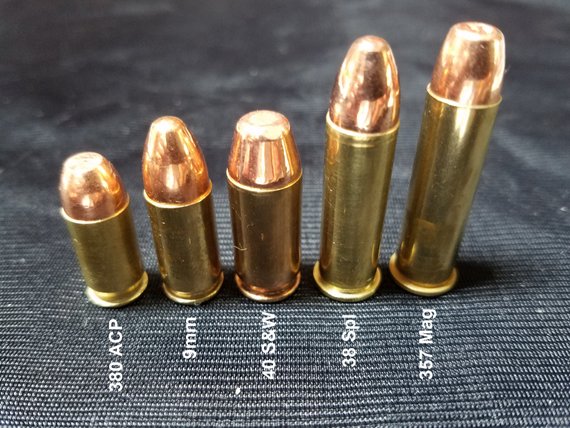
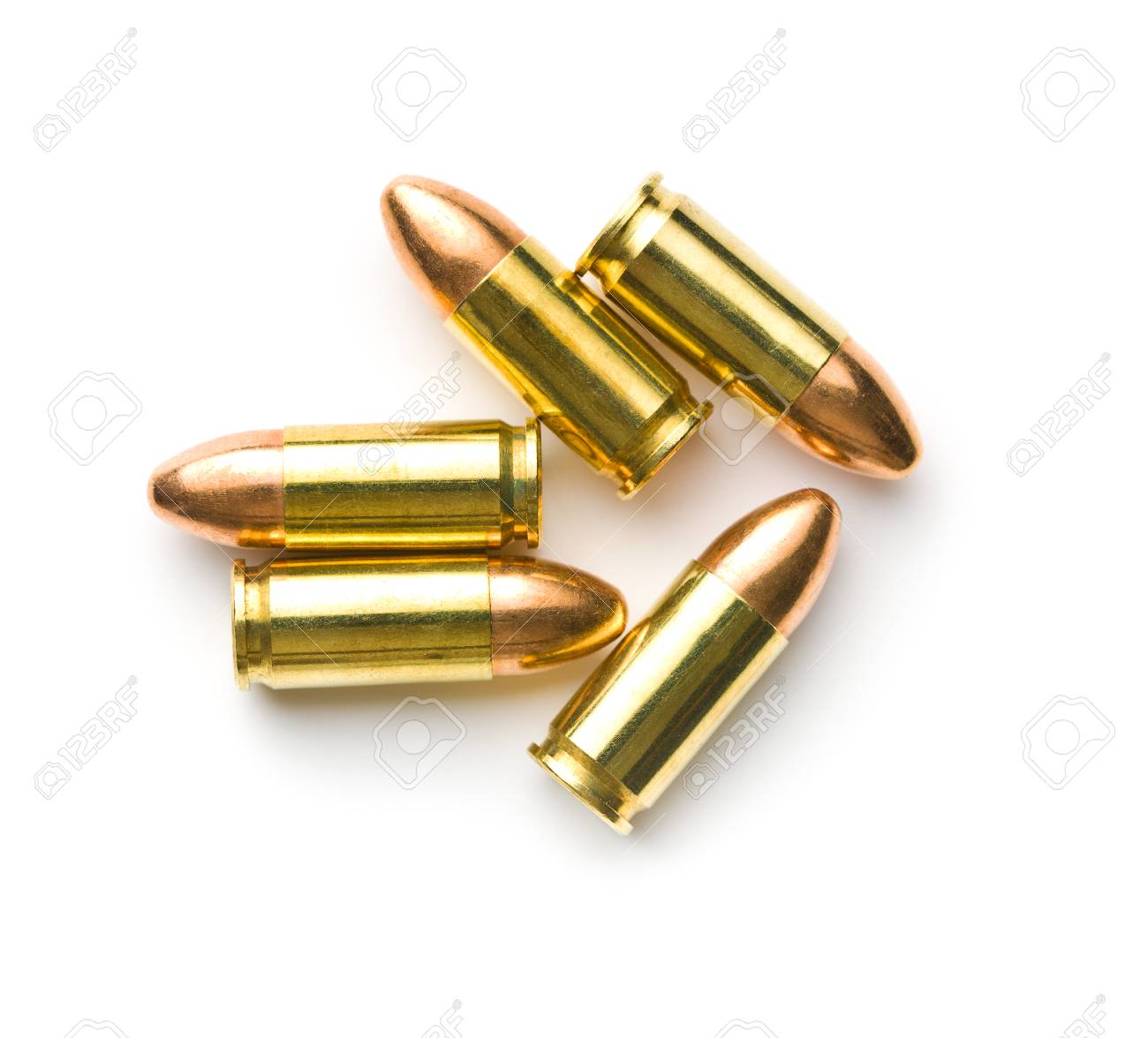
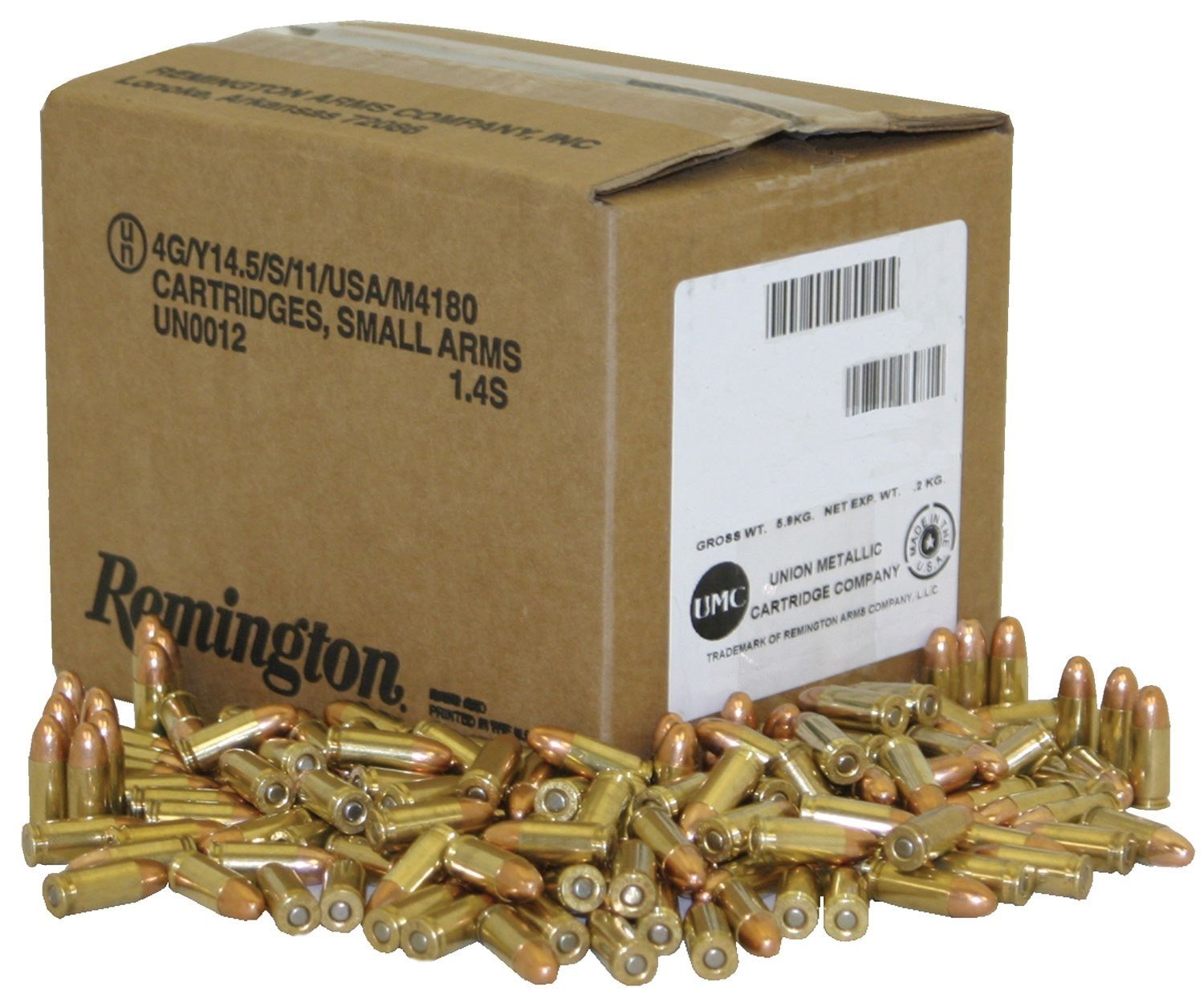
Clip A small metal device that holds ammo so it can be loaded into a magazine, although because the term has been used incorrectly for so long, it is now considered correct by some people to use the term when referring to a magazine. In my personal opinion, there is no certain number of years of incorrect usage that suddenly makes an incorrect term correct.
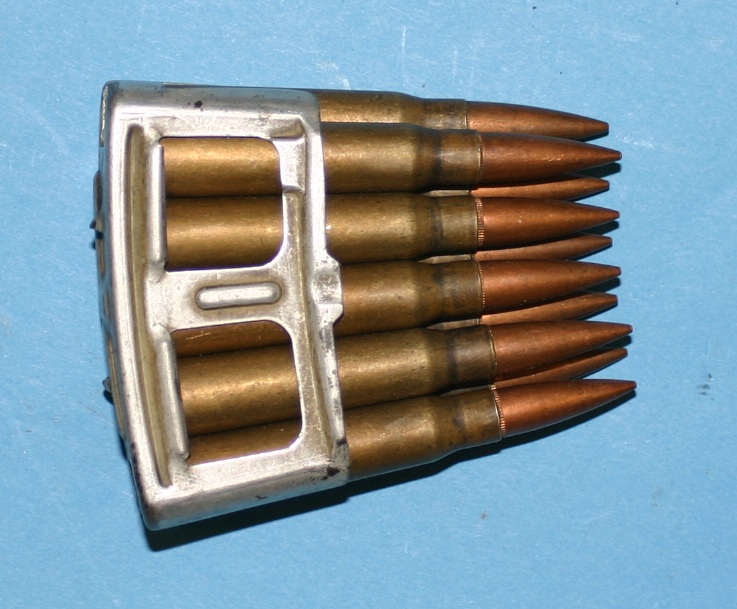 Charger or Stripper Clip
A device similar to a clip, but has a slightly different function. A stripper clip/charger differs
from a clip in that is not retained in the gun after the ammunition is loaded into the magazine.
Charger or Stripper Clip
A device similar to a clip, but has a slightly different function. A stripper clip/charger differs
from a clip in that is not retained in the gun after the ammunition is loaded into the magazine.
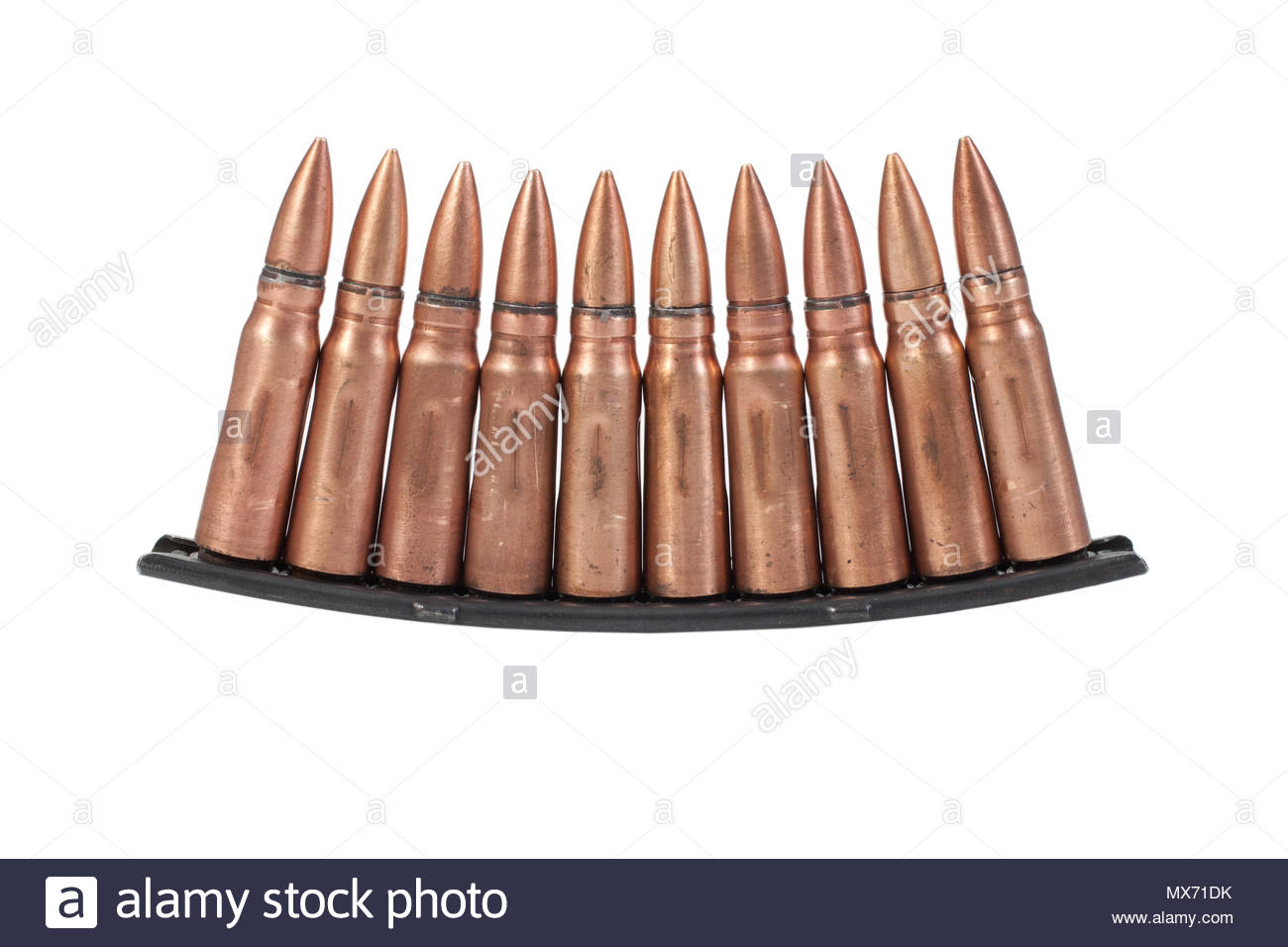
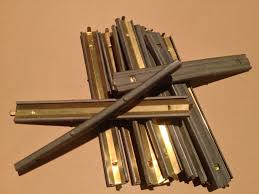 Magazine
The housing or container, usually detachable, that holds the ammunition in a firearm. Many people
associate the word magazine with semi-auto firearms, but some other types of firearms also use
magazines also such as many bolt action rifles or even a few shotguns such at the Mossberg 590
magazine fed shotgun. Some rifles, such as a Marlin 60 or a Winchester 94, or a Winchester 1200
shotgun house cartridges or shells in a magazine tube connected underneath the barrel of the gun.
Magazine
The housing or container, usually detachable, that holds the ammunition in a firearm. Many people
associate the word magazine with semi-auto firearms, but some other types of firearms also use
magazines also such as many bolt action rifles or even a few shotguns such at the Mossberg 590
magazine fed shotgun. Some rifles, such as a Marlin 60 or a Winchester 94, or a Winchester 1200
shotgun house cartridges or shells in a magazine tube connected underneath the barrel of the gun.
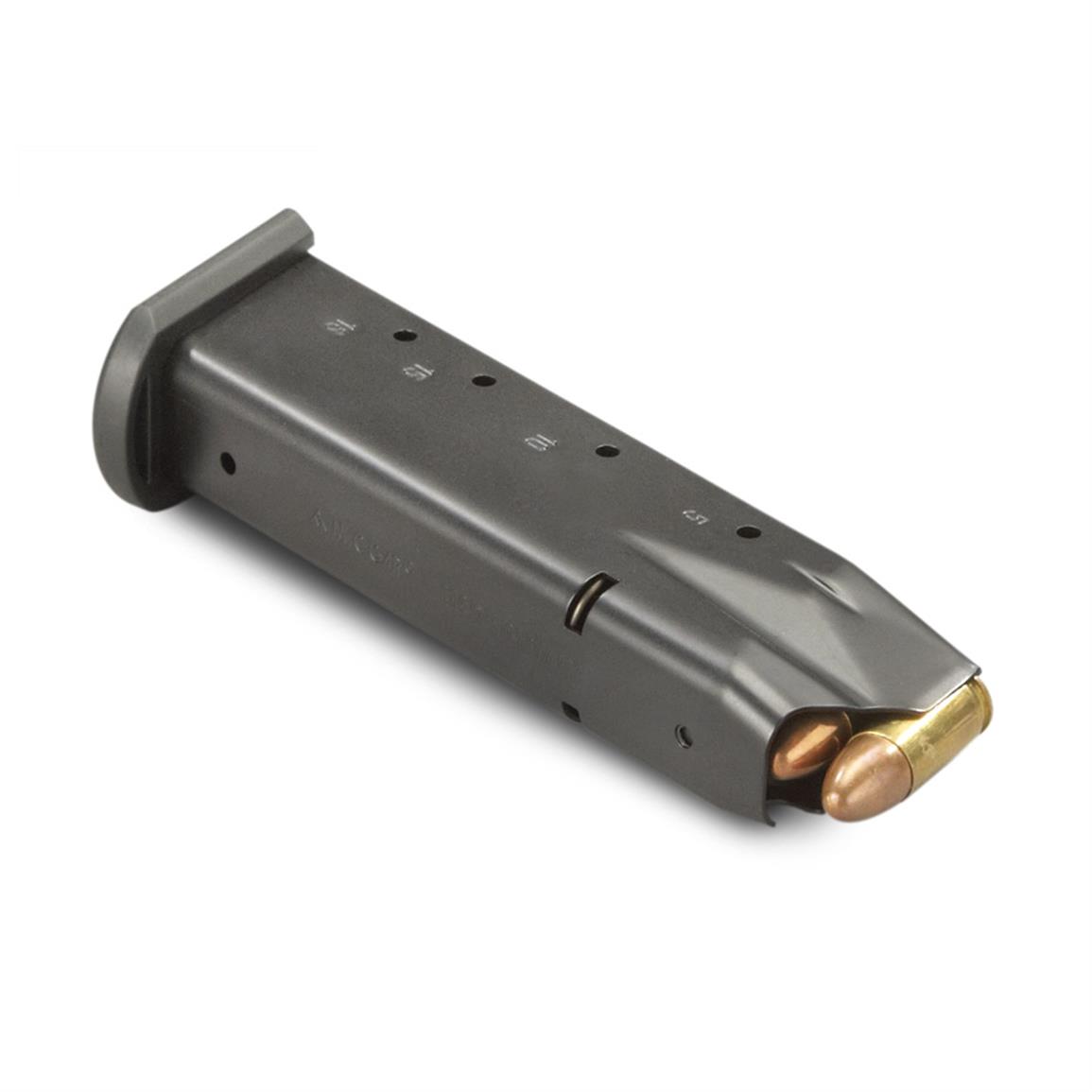
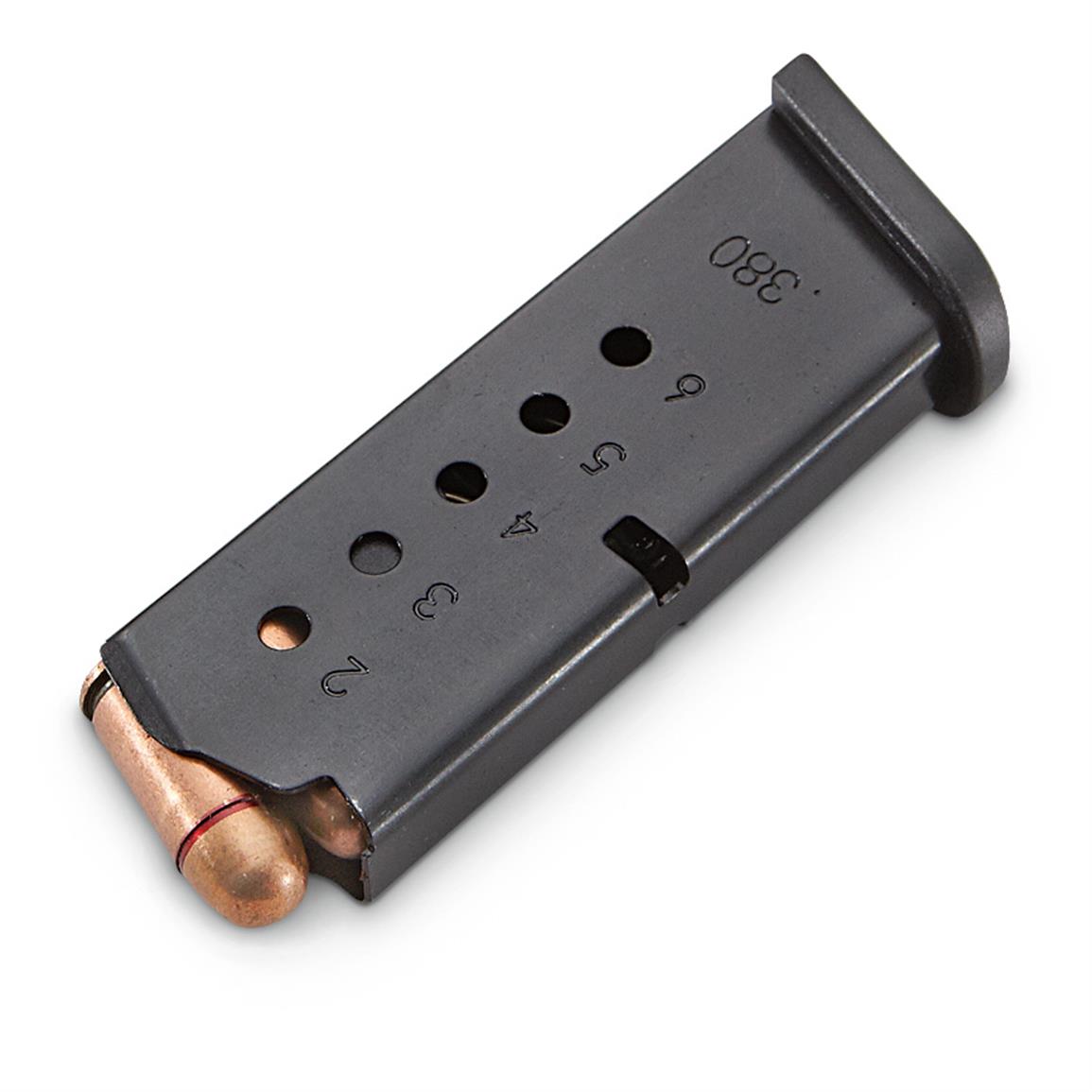
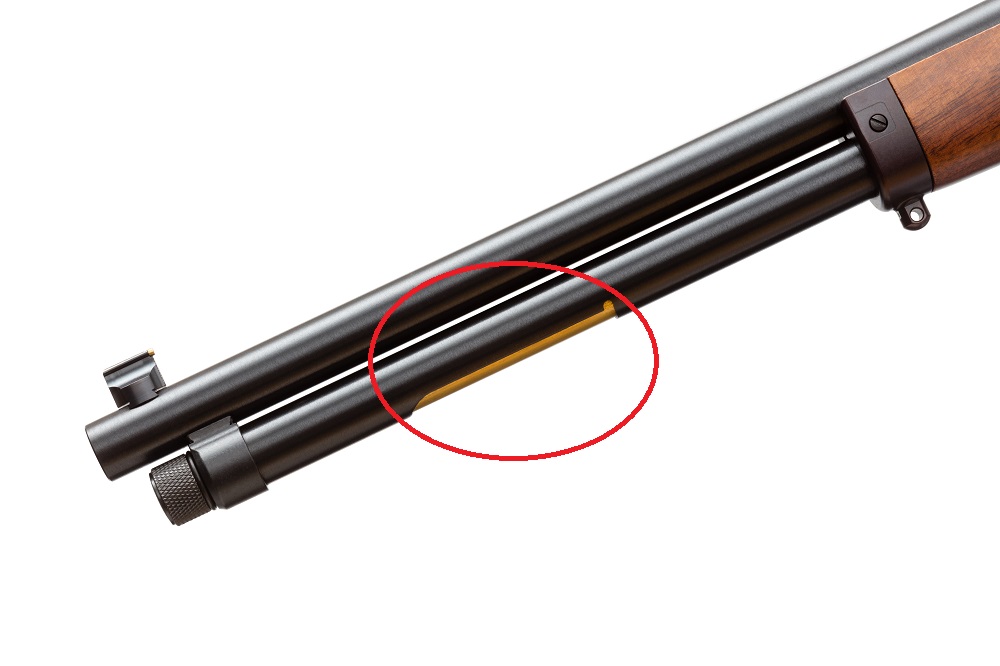
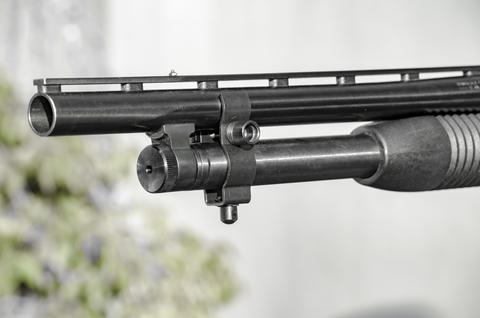 Loading using clips and stripper clips
A picture of a rifle clip, a rifle magazine being loaded with a clip, and a pistol magazine being loaded with a stripper clip.
Loading using clips and stripper clips
A picture of a rifle clip, a rifle magazine being loaded with a clip, and a pistol magazine being loaded with a stripper clip.

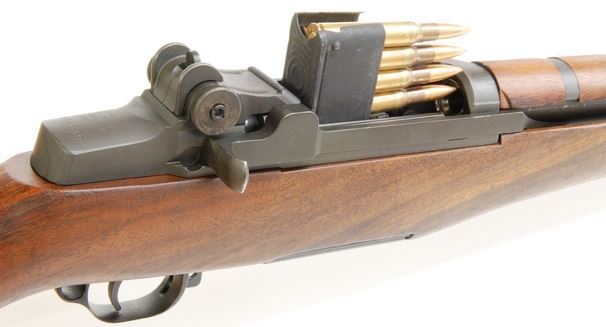
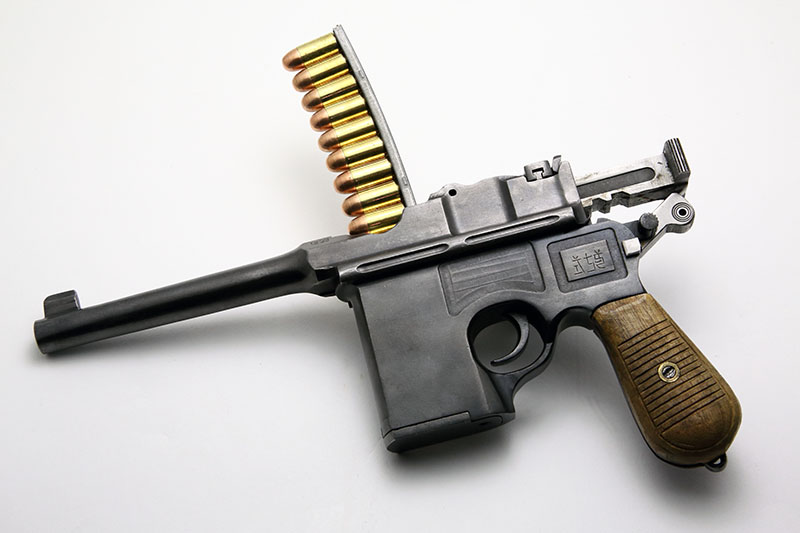 Drop the Clip or Dropped the Clip
This is a colloquial phrase meaning to remove the magazine from a firearm, but it's technically
incorrect. A much more correct phrase is "ejected the magazine from the pistol/rifle."
Drop the Clip or Dropped the Clip
This is a colloquial phrase meaning to remove the magazine from a firearm, but it's technically
incorrect. A much more correct phrase is "ejected the magazine from the pistol/rifle."
Double Action Gun (DA) A gun that can be fired with an un-cocked hammer by simply pressing the trigger, or by first cocking the hammer then pressing the trigger. Many people refer to this as a DA/SA firearm however, this is not necessary, because by definition, "double action gun" means a gun with both trigger actions. A good example of this is a Smith and Wesson model 66 revolver or a Sig Sauer standard 229.
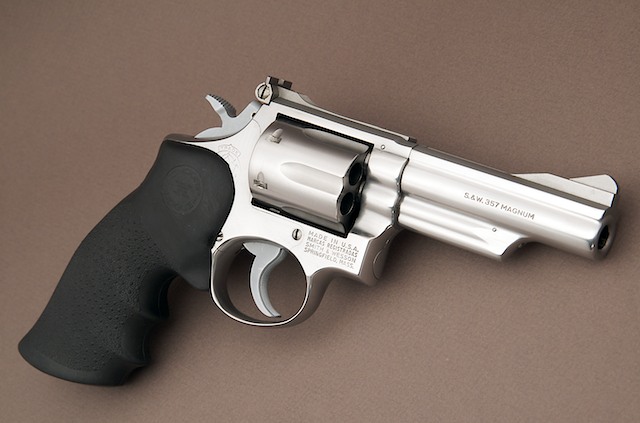
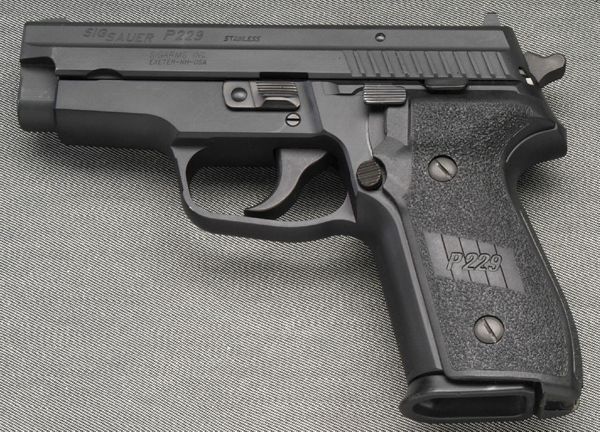 In recent years, it has become more common and may now be an industry standard to use DA/SA
because some manufacturers list their pistols this way in the descriptions or in the user manuals.
DA/SA means double action/single action and has become common usage to differentiate between
a double action gun and a double action only gun. See next definitions for further clarification.
Additional note:
Some double action pistols will have a safety, such as Taurus Models, some will not, such as Sig models.
Most DA pistols that don't have a safety will have a decocker, which lowers the hammer without firing the
cartridge. Also, some will have a lever than can be used as both, such as a standard Beretta 92 and many
older Smith and Wesson models. If the hammer is cocked, you press the decocker down and the hammer lowers
and if you leave the decocker in the down position, it deactivates the trigger, so it acts as a safety.
This is known as a two-stage decocker. Sigs and some others have a single-stage decocker which lowers the
hammer only and does not act as a safety other than it prevents the hammer from hitting the primer. Some
are available either way, such as the Beretta 92FS (two-stage decocker) or the 92G (single-stage decocker).
In recent years, it has become more common and may now be an industry standard to use DA/SA
because some manufacturers list their pistols this way in the descriptions or in the user manuals.
DA/SA means double action/single action and has become common usage to differentiate between
a double action gun and a double action only gun. See next definitions for further clarification.
Additional note:
Some double action pistols will have a safety, such as Taurus Models, some will not, such as Sig models.
Most DA pistols that don't have a safety will have a decocker, which lowers the hammer without firing the
cartridge. Also, some will have a lever than can be used as both, such as a standard Beretta 92 and many
older Smith and Wesson models. If the hammer is cocked, you press the decocker down and the hammer lowers
and if you leave the decocker in the down position, it deactivates the trigger, so it acts as a safety.
This is known as a two-stage decocker. Sigs and some others have a single-stage decocker which lowers the
hammer only and does not act as a safety other than it prevents the hammer from hitting the primer. Some
are available either way, such as the Beretta 92FS (two-stage decocker) or the 92G (single-stage decocker).
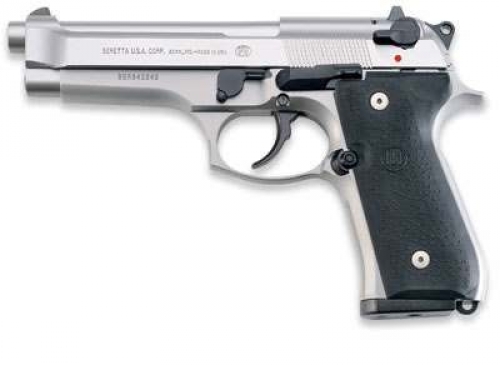
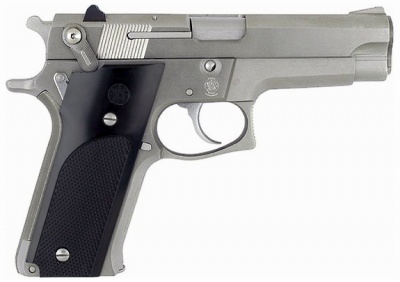
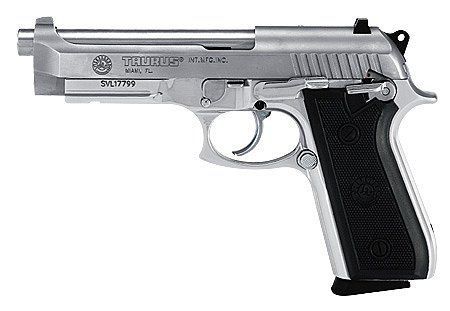 Double Action Trigger (different than Double Action Gun)
A trigger that cocks the hammer and releases it. By this definition, DA and DAO pistols
both have a double action trigger, however, according to a few people, this is improper usage.
Double Action Only Gun (DAO)
A gun that is fully un-cocked and can only be fired by pressing the trigger through a full trigger
stroke. Double action only pistols cannot be cocked at all. The hammer is always forward except
when the trigger is being engaged.
Many pistols are available as DA or DAO and are almost identical in appearance. A DAO model
will usually have a bobbed hammer since the hammer cannot be cocked. It's also common to
convert DA to DAO. For instance, the Smith and Wesson model 60 and Sig 229 mentioned
previously are available as DAO pistols.
Double Action Trigger (different than Double Action Gun)
A trigger that cocks the hammer and releases it. By this definition, DA and DAO pistols
both have a double action trigger, however, according to a few people, this is improper usage.
Double Action Only Gun (DAO)
A gun that is fully un-cocked and can only be fired by pressing the trigger through a full trigger
stroke. Double action only pistols cannot be cocked at all. The hammer is always forward except
when the trigger is being engaged.
Many pistols are available as DA or DAO and are almost identical in appearance. A DAO model
will usually have a bobbed hammer since the hammer cannot be cocked. It's also common to
convert DA to DAO. For instance, the Smith and Wesson model 60 and Sig 229 mentioned
previously are available as DAO pistols.
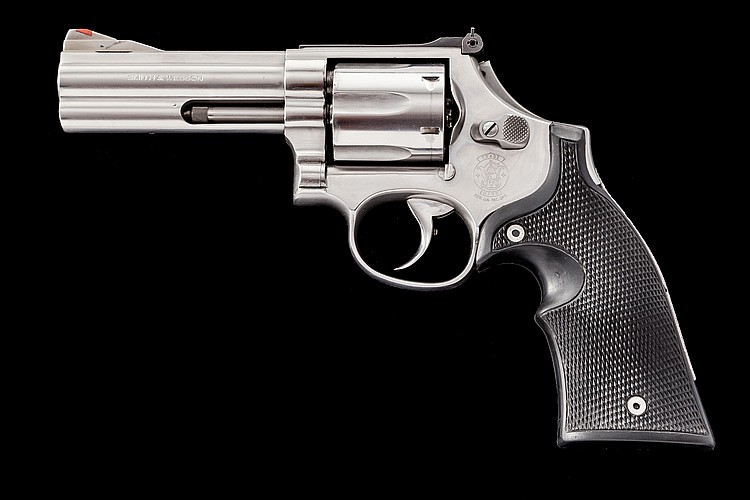
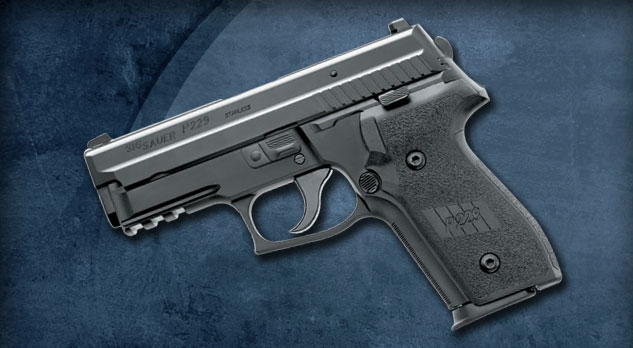 Single Action Gun (SA)
A gun that can be fired only if the hammer is cocked before the trigger is pressed. Single action
semi auto pistols will have an external safety so the gun can be carried with the hammer cocked
and the safety on.
A good example of this is a Colt Singe Action Army revolver, most of the revolvers that are considered
colloquially to be cowboy revolvers, standard 1911 pistols, or standard Browning Hi-Power pistols.
Single Action Gun (SA)
A gun that can be fired only if the hammer is cocked before the trigger is pressed. Single action
semi auto pistols will have an external safety so the gun can be carried with the hammer cocked
and the safety on.
A good example of this is a Colt Singe Action Army revolver, most of the revolvers that are considered
colloquially to be cowboy revolvers, standard 1911 pistols, or standard Browning Hi-Power pistols.
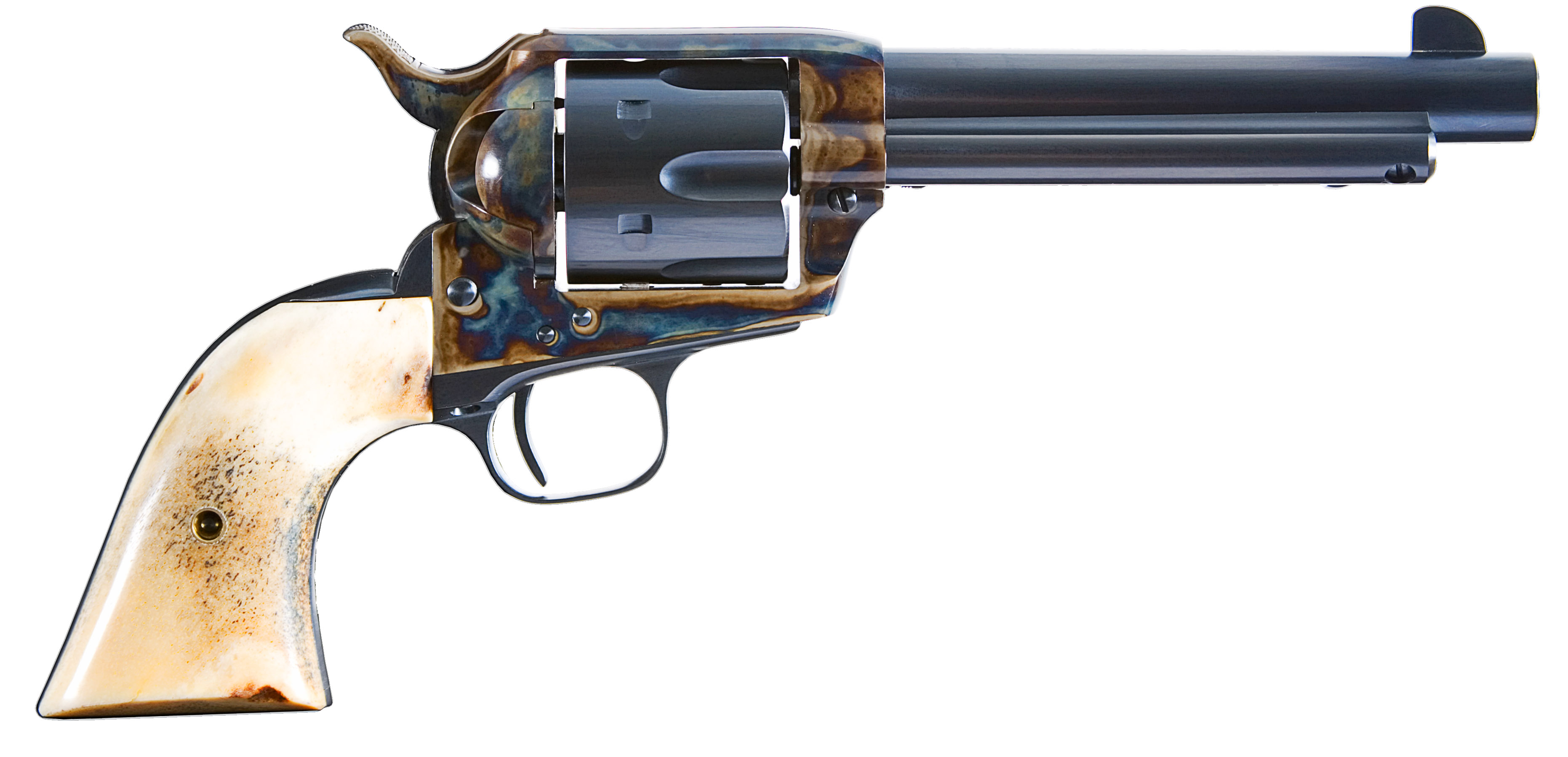
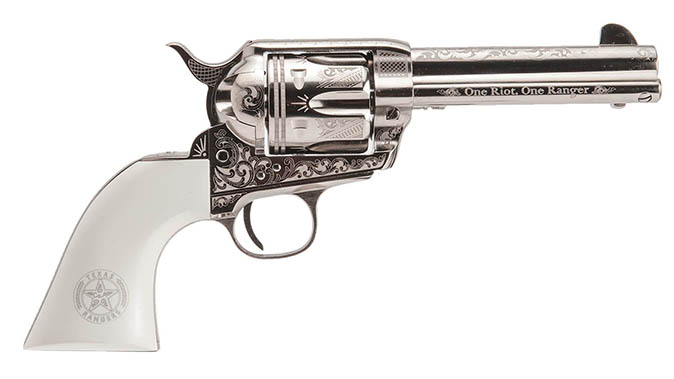
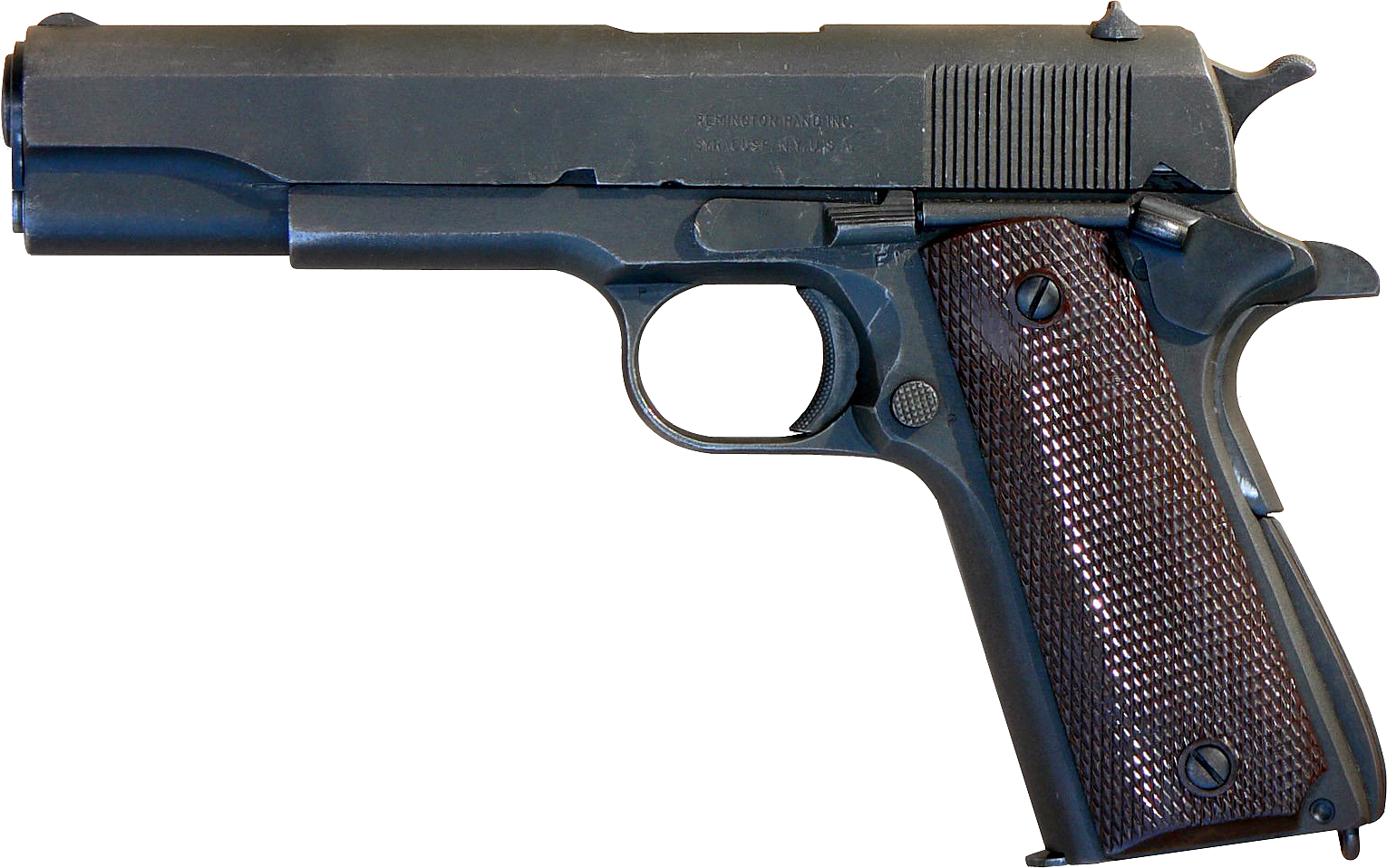
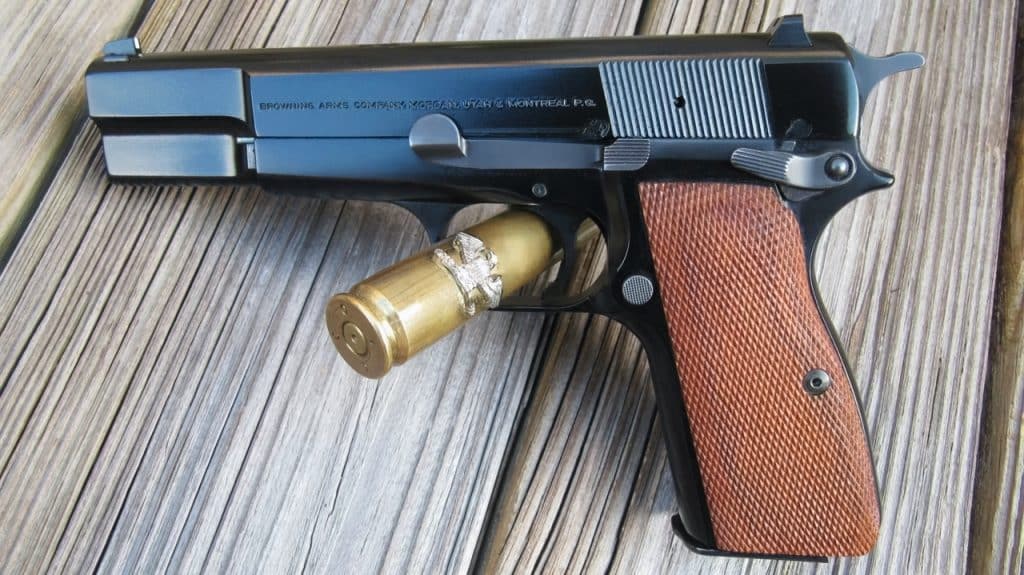 Variant
Any gun that isn't one of the three preceding types.
A good example of this is a Glock or ah HK P7. As stated in the next section, a Glock is partially cocked and the
trigger releases the striker the rest of the way to fire the cartridge. An H&K P7 has a grip lever or more properly,
a cocking lever, that cocks the gun when pressed, then the trigger releases the striker to fire the cartridge.
Variant
Any gun that isn't one of the three preceding types.
A good example of this is a Glock or ah HK P7. As stated in the next section, a Glock is partially cocked and the
trigger releases the striker the rest of the way to fire the cartridge. An H&K P7 has a grip lever or more properly,
a cocking lever, that cocks the gun when pressed, then the trigger releases the striker to fire the cartridge.
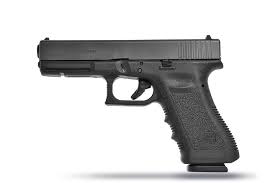
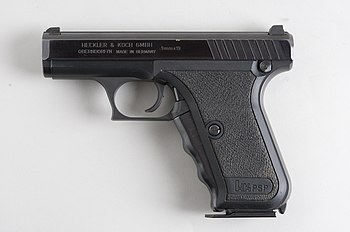 Double Action Only Glock
By definition, Glocks aren't DAO. In standard carry mode, a Glock is partially cocked.
The Glock company term for this is Safe Action. Many people argue that Glocks are
DAO because the trigger is the same every time, however "the trigger is the same every
time" isn't the definition of a DAO gun. See above for the definition of that term.
A Glock is an example of a variant.
Semi-automatic Revolver
A made up term. Although rare, there is such a thing as a self-cocking revolver and a self-loading revolver,
but that is never what anyone means when they use the term semi-automatic revolver. The term is sometimes
seen in newspaper articles, and is fair evidence that the author knows very little about guns.
Double Action Only Glock
By definition, Glocks aren't DAO. In standard carry mode, a Glock is partially cocked.
The Glock company term for this is Safe Action. Many people argue that Glocks are
DAO because the trigger is the same every time, however "the trigger is the same every
time" isn't the definition of a DAO gun. See above for the definition of that term.
A Glock is an example of a variant.
Semi-automatic Revolver
A made up term. Although rare, there is such a thing as a self-cocking revolver and a self-loading revolver,
but that is never what anyone means when they use the term semi-automatic revolver. The term is sometimes
seen in newspaper articles, and is fair evidence that the author knows very little about guns.
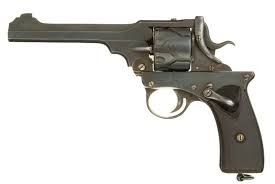
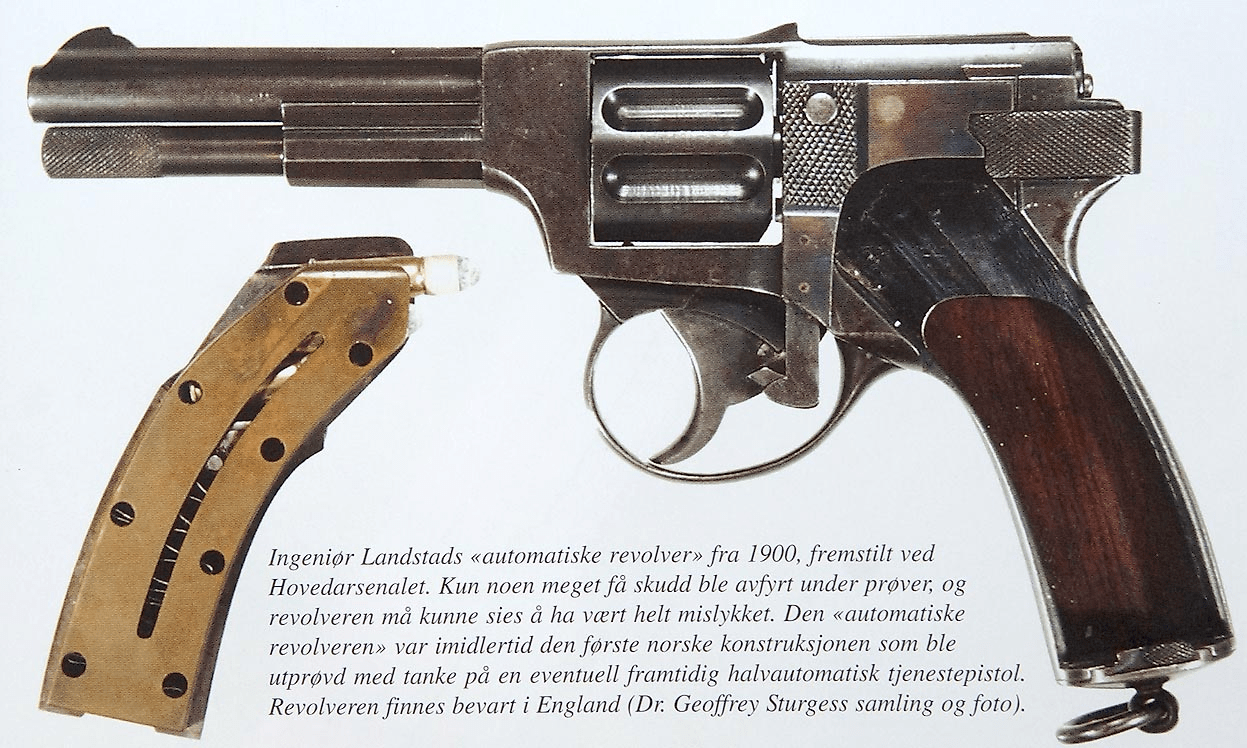
Assault Weapon Another made up term. The closest real term is assault rifle, which has a specific meaning. The term Assault Weapon was created for the 1994 assault weapons ban, but has no clear specific definition.
Assault Rifle According to the U.S. Army, the actual definition of and assault rifle is, a selective-fire rifle chambered for a cartridge of intermediate power. Two examples are an AK-47 or an M16. Here are pictures of both. Note, rifles that you can purchase in a gun store and leave with the same day are AK-47 semi-auto variants or AR-15s. Neither one of those rifles are full auto or select fire. They are semi-automatic only. It is true that they look the same, but they do not function the same in that, as stated, are semi-auto only, and have no option to select burst-fire or full automatic fire like a actual assault rifle does. You can purchase full auto AK-47s and M16s, but those are known as class III, title 2, or NFA rifles and the process to purchase one generally takes between several months and a year. You cannot go into any gun store in the country and legally purchase a full auto anything and leave with it the same day, nor can you buy one legally from another individual without going through the same process.
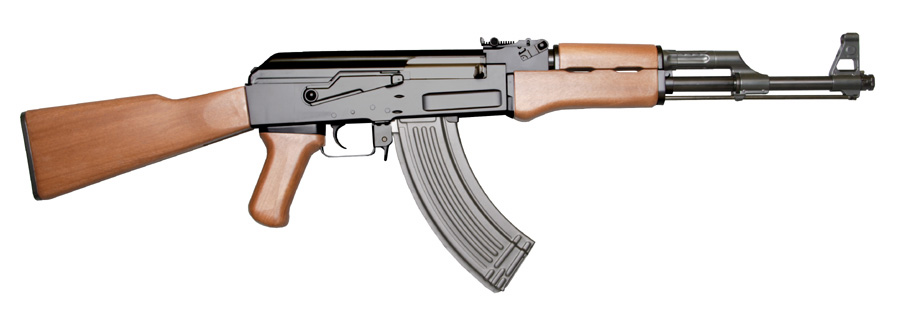

Pull/Press/Depress/Squeeze/Engage/Activate Various terms used to mean the activation or manipulation of the trigger. As with most other existing theories, there is some argument among the "experts" as to which one is correct, or as to whether it makes any difference which term you use.
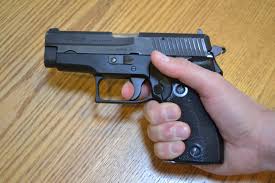
Semi-Automatic or Semi-Auto Just for clarification, a semi-automatic gun is a gun where the mechanism automatically loads the next round into the chamber but fires one, and only one, round each time the trigger is activated. Automatic or Auto Even though this term can mean a semi-automatic gun, it's a little more precise and less confusing, to use the term auto-loader or self-loader. Fully Automatic or Full Auto A gun that continues to fire as long as you hold the trigger or until it runs out of ammo. Some people argue that Full or Fully should be left off because automatic means the same thing. This is actually true, but people use the term Full or Fully Auto to distinguish that they mean non-semi automatic because so many people confuse the two.
Hammer and Striker A hammer is an external piece that strikes the firing pin. A striker is internal piece that strikes the primer directly (this is a very basic description). Note the pictures below. The 1911 has an external hammer, the Glock does not.
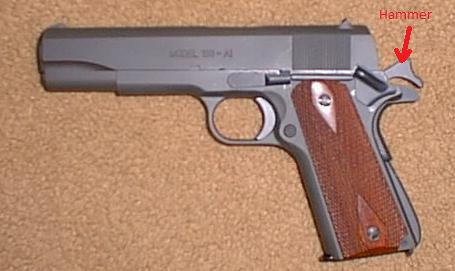
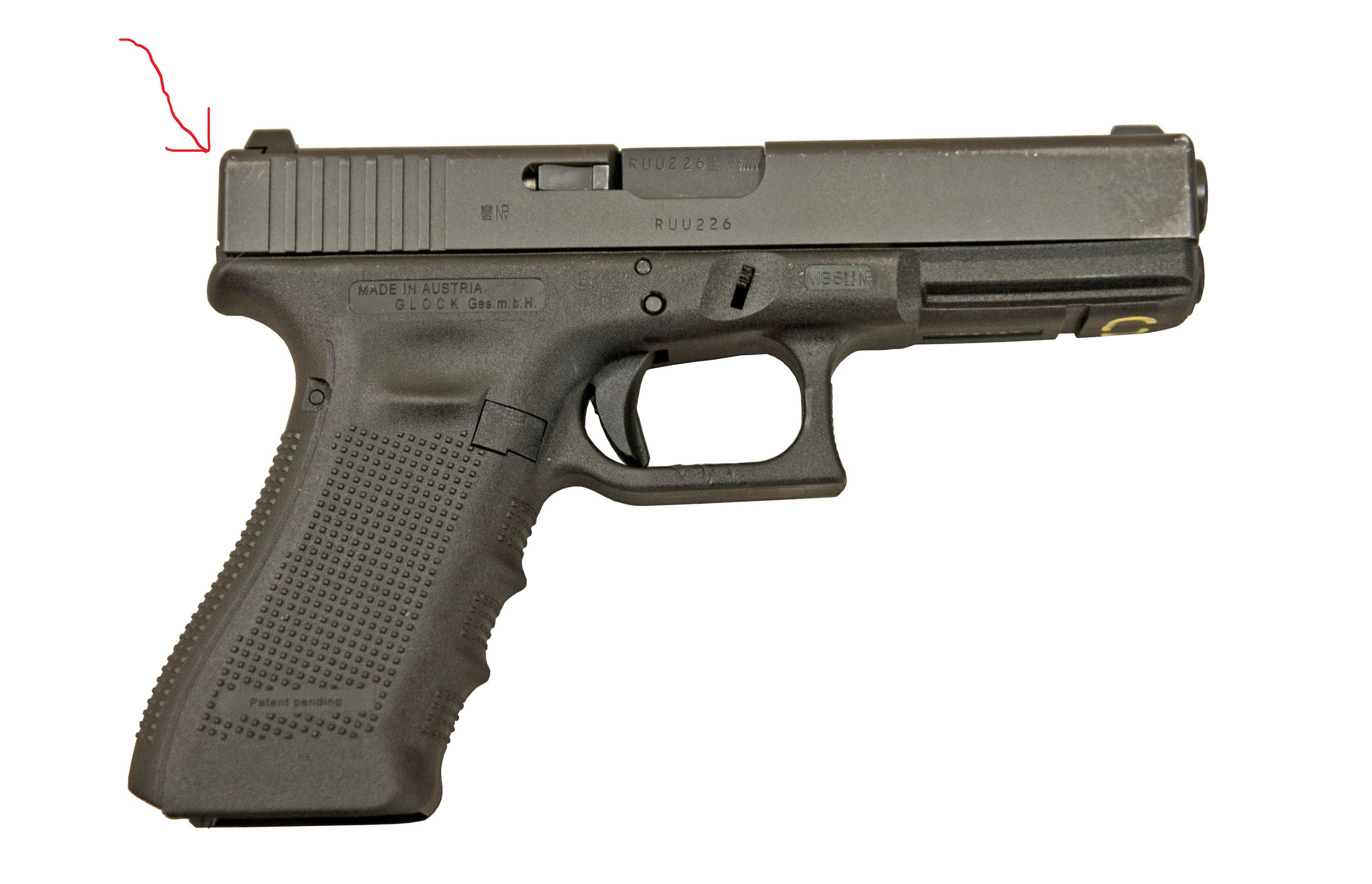
Decocker A lever on a gun that allows the hammer or striker to disengage without striking the firing pin. The decocker can be used as a safety on some pistols because it disables the trigger, but "decocker" and "safety" are not interchangeable terms. Additionally, the decocker does not disable the trigger on all models, but only on pistols that have a two-stage decocker, such as some Beretta or S&W models. Also, the decocker isn't in the same spot on all guns. On Sigs, it's on the left side, on some other guns it's on both sides, and a few have ambidextrous decockers so it's on both sides.
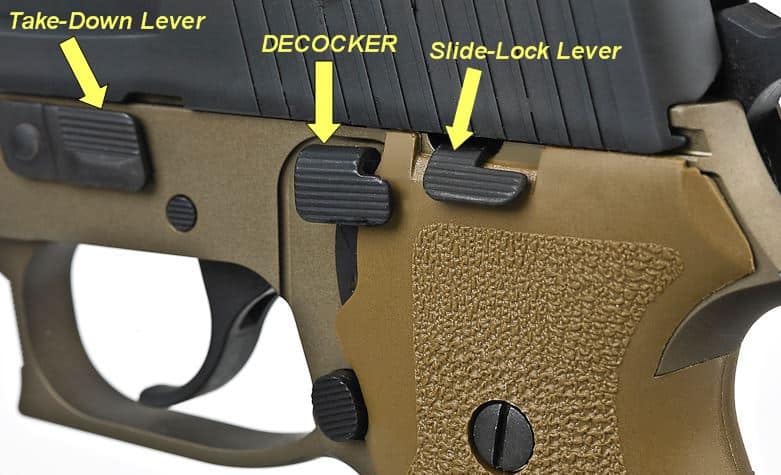 Two Stage Decocker
A decocking lever that does not automatically reset. After you activate
the decocker, you must manually deactivate it before the gun will fire.
Single Stage Decocker
A decocking lever that automatically resets after activation.
Safety
A device that disables the trigger, blocks the firing pin, or both, so the gun cannot be fired.
Two Stage Decocker
A decocking lever that does not automatically reset. After you activate
the decocker, you must manually deactivate it before the gun will fire.
Single Stage Decocker
A decocking lever that automatically resets after activation.
Safety
A device that disables the trigger, blocks the firing pin, or both, so the gun cannot be fired.
Accidental Discharge The unintentional discharge of a firearm due to circumstances beyond the control of the user. Negligent Discharge The unintentional discharge of a firearm due to a negligent action by the user. This is the term that should be used when referring to the vast majority of unintentional discharges with firearms. Here is a video of an negligent discharge by an instructor. You will be hard pressed to find any examples of a true accidental discharge because accidental implies no error on the user's part. example of a negligent discharge Unintentional Discharge A generic term that can refer to any firing of a gun that was not intentional, regardless of whether it was accidental or negligent. Go Off A term that too often implies that a gun can just suddenly fire for no reason. Guns don't just suddenly fire for no reason. While it is possible to have a true accidental discharge, almost all unintentional discharges are negligent, not accidental. See other terms in the section for more information.
Arsenal A government establishment where military equipment or munitions are manufactured or stored. This is commonly misused as anti-gun rhetoric when referring to the personal collection of someone who owns more than one gun or more than a few rounds of ammo, however the term itself originally referred to the building as described here, not to the guns themselves, but that has come to be the common usage in the last few years.
Artillery A large bore weapon designed to be operated by a crew of several people. Colloquially used as slang to refer to any firearm.
Caliber The diameter of the bullet in the cartridge, or the diameter of the bore of the gun. As an aside, the correct term for the mechanical piece on a car's brake system is "caliper" with a P. Cartridge Designation A name for a specific cartridge. Note that it may include the caliber designation but caliber and cartridge designation are different. Example A .40 S&W cartridge does contain a .40 caliber bullet, but so does a 10 mm cartridge. The bullet itself is the same and designated as .40 caliber or 10 mm but the cartridge designation indicates which specific gun it will fire out of. Even though .40 S&W and 10 mm cartridges both contain a bullet that is the same caliber, they cannot be fired from the same gun because the overall cartridge dimensions are different.
Kill To cause death. Murder The unjustified killing. Contrary to what many people will tell you, sometimes killing is justified, and there are laws and precedents to back that up.
High Capacity Magazine Any magazine that holds more rounds than the standard magazine that comes with a given model of handgun. For instance, a 33 round magazine is a high capacity magazine for a Sig 226. A 15 round magazine is not, since some Sig 226s come from the factory with 15 round magazines.
Lethality The ability of an item to eventually cause death. This is not interchangeable with "stopping power" or "effectiveness." Stopping Power (Effectiveness) A colloquial term meaning the ability of an item to stop an adversary, regardless of whether death occurs. Stopping an Adversary This means rendering a attacker incapable of further hostile action, regardless of whether death occurs, or simply stopping the attack even if there is no physical damage. If you pull out a gun and the attacker runs away, you have stopped the adversary. Contrary to extremely popular belief, the term is not interchangeable with "killing." Knock Down Power Another made up term. Bullets from guns you can hold in your hands and fire do not have enough power to knock a person down. The person may fall down after being hit due blood loss but the bullet itself will not knock the person down. Here are a few videos to demonstrate. A man being shot by an AK-47 A man being shot by an high power .308
Gun Registration An extremely overused, and normally misused term. Most states in the U.S. do not require gun registration, and there is no national registration.
The Second Amendment Gives Us The Right To Own Firearms The second amendment guarantees our right to own firearms. It does not give us that right. That's why the rights protected by the Bill of Rights have been called "self-evident." The Second Amendment Applies to the Militia The second amendment applies to the people. That's why it says, "...the right of the people..." The ability to maintain a well regulated Militia is the reason.
Tactical An extremely overused, but not necessarily misused term. The basic definition of "tactic" is simply the procedure used to perform a given task. The word tactical has, in the last few years, become a standard to describe everything you can think of; tactical knives, tactical flashlights, tactical belts, etc. By definition, any item on the planet can be called tactical, because every that exists was manufactured to fulfill some specific task. In common usage, the term means something that is designed for fighting or self defense. For instance, a shotgun with an 18 inch barrel set up for home defense is a tactical shotgun, as opposed to a shotgun with a 28 inch barrel set up for sporting clays or hunting, which is considered a sporting or hunting gun.
Unload To remove the cartridges from a gun or magazine. Not interchangeable with "clear." Clear To remove the magazine and cartridges from a gun, and to leave it locked open in an un-fireable condition. Unloaded vs. Cleared The gun on the left is unloaded, at least as far as you can tell, and yes, it's possible for there to be a live, unfired cartridge in the chamber, but the gun on the right is cleared.
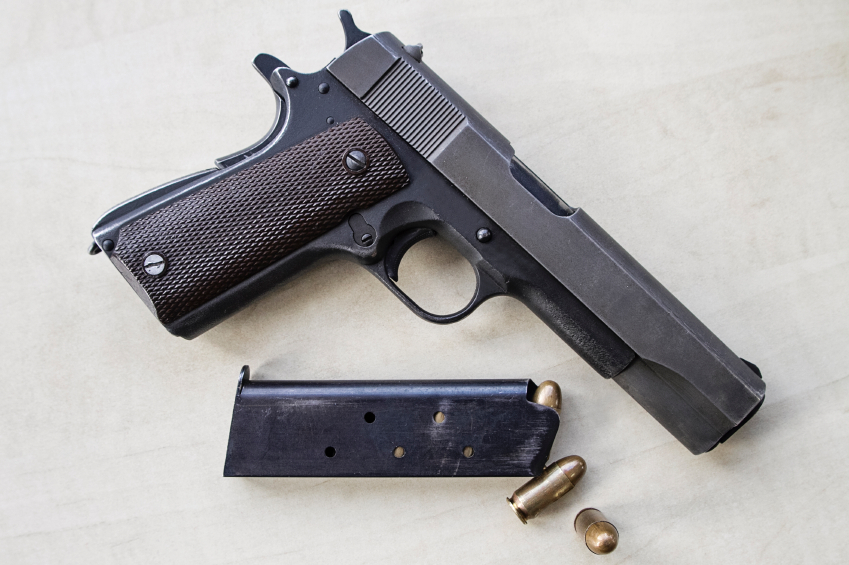
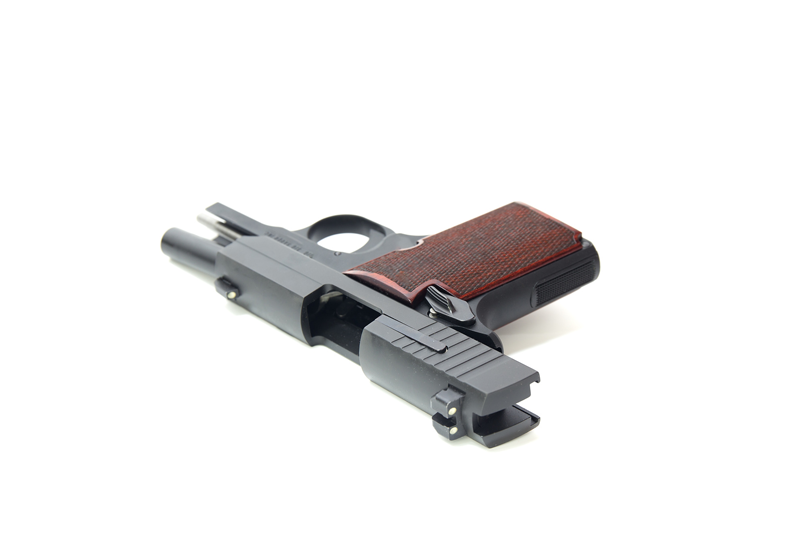
The Liberal Media I'm going to catch flak for this, but this term is used to mean "any news source that prints or reports anything that I disagree with." Many news agencies are in fact liberal, but the term is grossly overused.
Pointing the Gun in a Safe Direction A phrase that has no real meaning to most people. A better phrase is "in a direction where the gun is not pointed at anything you don't want to shoot or destroy," or more simply, "never point a gun at anything you don't want to destroy."
Robbery The taking of property through the use of excessive/deadly force, or the taking of property while putting a person in fear for his or her life. When you come home and find your house has been broken into and your lawnmower stolen, your house has been burglarized; you have not been robbed. When a guy grabs your wallet at the grocery store counter and runs off with it, that is larceny. Putting a gun in your face or a knife to your throat and forcing you to give up your wallet, THAT'S robbery.
The Gun Show Loophole A fictional dilemma. At gun shows, the same laws apply to guns sales that apply to any other gun sales within the same state. Gun dealers are required to process the same paperwork at a gun show that they process when selling from their store. Sales between individuals are also governed by whatever law applies to person-to-person sales in that state. Most states don't require background checks for sales between individuals, and sometimes individuals sell guns to other individuals at gun shows, but this isn't a gun show loophole. The same exact transaction between two individuals could also legally take place in the parking lot of the gas station or at the seller's or buyer's house. It does not have to happen at a gun show.
The Glock 7 or the Ceramic Gun That Can't Be Seen in a Metal Detector A fictional gun. It doesn't exist and never did. That guy who tells you he owns or knows someone who owns one, and is serious, is an idiot that knows nothing about guns, or he thinks YOU are an idiot and know nothing about guns.
Tactical Reload A reload style that was invented at Gunsite in the 70s to prevent dropping a finicky early style 1911 magazine in the sand. It was not invented for, nor intended to be used during a gunfight, however it has come be taught by many instructors as a way to top off a gun during the so-called "lull" in a gunfight. Regardless of your opinion on whether or not any of this matters, here is a demonstration of the tactical reload and a second video of another instructor demonstrating the difference between a tactical reload and a reload with retention. Sig Academy instructor demonstrating a tactical reload Another instructor demonstrating a tactical reload vs. reload with retention
Bill Drill Originally a drill where you fired 6 fast but accurate shots onto a target, it has morphed for many shooters into a drill where you simply fire six shots onto a target as fast as possible and accuracy is very much a secondary consideration. Here is a video of Bill Wilson and Ken Hackathorn discussing it. Bill Wilson and Ken Hackathorn discussing the Bill Drill The El Presidente The original drill consisted of ALL of the following: three targets at 10 meters, a suitable service pistol, full charge ammo, and a concealment garment. You started facing fully away from the targets, hands and arms relaxed at your side, turned, engaged each target with two shots each, reloaded and engaged each target again with two shots. In order to pass the drill, you had to get all 12 shots in the A-zone, and it had to be done in under 10 seconds. It has now become common to refer to any 12 shots on three targets as an El Presidente, regardless of how closely the drill resembles the original drill, and to score based on the shooter's preferred scoring method, rather than the more difficult pass/fail scoring I mentioned. I was going to post some links here but I decided it would seem like I was calling out some specific shooters so I decided not to. Google "fast El Presidente drill" or something similar and many of the videos you find will be shooters (many of them very good, not denying it) shooting variations of it.
Civilian A person who is not in the armed forces. Colloquially used to refer to someone who is not a cop, fireman, or member of a private group.
I'm a nationally/regionally/state ranked shooter. This statement, in and of itself, doesn't mean anything. When someone tells you this in a bragging manner, or uses it to prove he really knows what he is talking about, ask him HOW he is nationally ranked. For instance, at the first major match I ever attended, I won the third place expert trophy. However, the catch is, there were only three experts. So even though I was third place expert, I was last in that category. The term nationally ranked doesn't necessarily mean nationally ranked really high. You could be the single worst shooter on the planet, but if you've competed in a national tournament, you're nationally ranked.